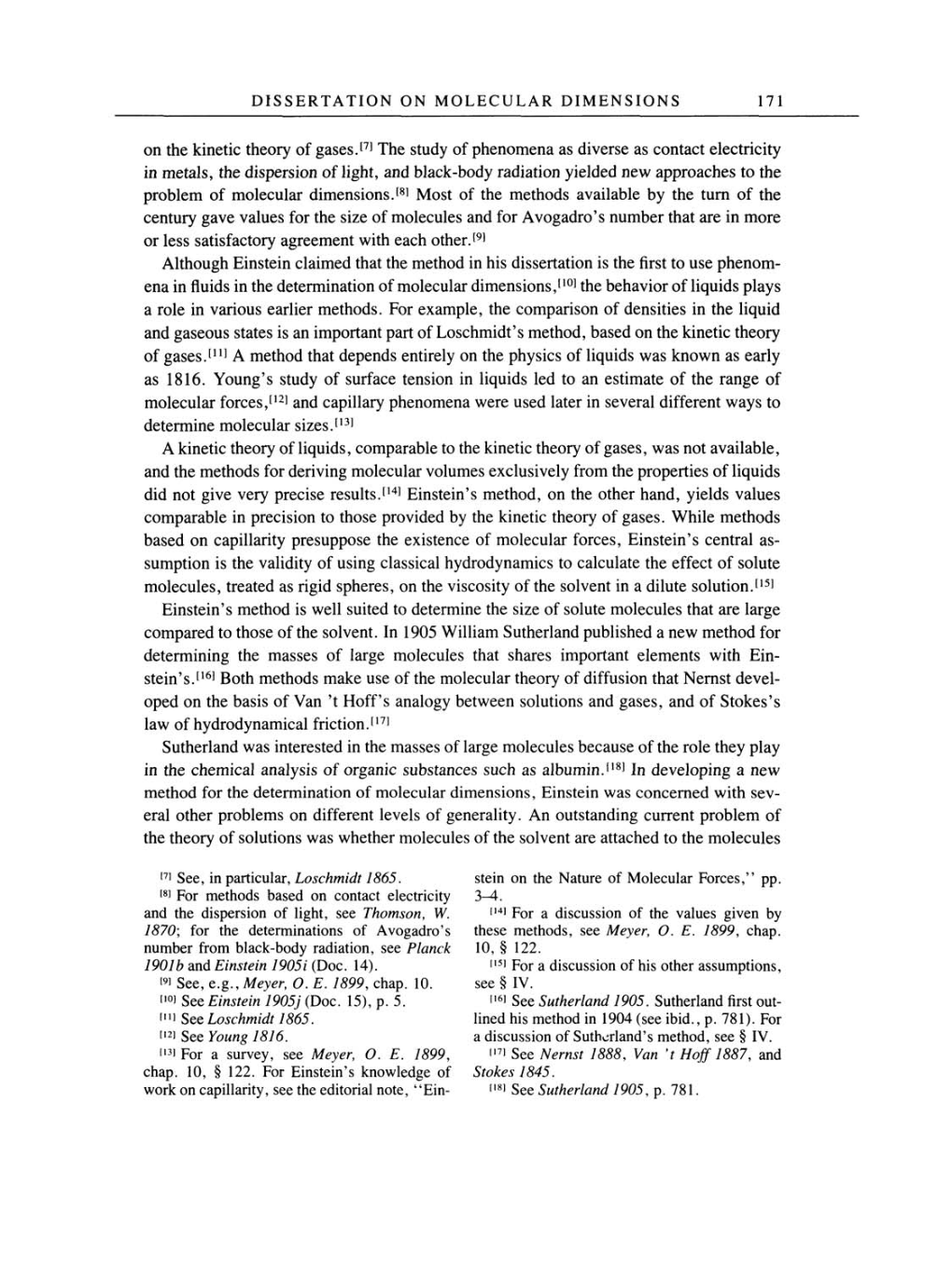DISSERTATION
ON MOLECULAR
DIMENSIONS
171
on
the kinetic
theory
of
gases.[7]
The
study
of
phenomena
as
diverse
as
contact
electricity
in metals,
the
dispersion
of
light,
and
black-body
radiation
yielded new
approaches
to
the
problem
of
molecular dimensions.[8] Most
of
the methods available
by
the
turn
of
the
century gave
values for the size
of
molecules and for
Avogadro's
number that
are
in
more
or
less
satisfactory agreement
with each
other.[9]
Although
Einstein claimed that the method
in
his dissertation
is
the first to
use phenom-
ena
in fluids in the determination
of
molecular
dimensions,[10]
the
behavior of
liquids
plays
a
role
in various
earlier
methods. For
example,
the
comparison
of
densities in the
liquid
and
gaseous
states
is
an
important part
of Loschmidt's
method,
based
on
the kinetic
theory
of
gases.[11]
A method that
depends entirely
on
the
physics
of
liquids was
known
as
early
as
1816.
Young's
study
of
surface tension
in
liquids
led to
an
estimate
of
the
range
of
molecular
forces,[12]
and
capillary phenomena were
used later
in
several
different
ways
to
determine molecular
sizes.[13]
A kinetic
theory
of
liquids, comparable
to
the kinetic
theory
of
gases, was
not available,
and the methods for
deriving
molecular volumes
exclusively
from the
properties
of
liquids
did not
give very precise
results.[14]
Einstein's
method,
on
the other hand,
yields
values
comparable
in
precision
to
those
provided by
the kinetic
theory
of
gases.
While methods
based
on capillarity presuppose
the existence
of
molecular
forces,
Einstein's
central
as-
sumption
is
the
validity
of
using
classical
hydrodynamics
to
calculate the effect
of
solute
molecules,
treated
as rigid spheres, on
the
viscosity
of
the solvent
in
a
dilute
solution.[15]
Einstein's
method
is
well suited to determine the size
of
solute molecules that
are large
compared
to those
of
the solvent.
In 1905
William Sutherland
published a new
method for
determining
the
masses
of
large
molecules that shares
important
elements with Ein-
stein's.[16]
Both
methods
make
use
of
the molecular
theory
of
diffusion that Nernst
devel-
oped
on
the
basis
of
Van
't Hoff's
analogy
between solutions and
gases,
and
of
Stokes's
law of
hydrodynamical
friction.[17]
Sutherland
was
interested
in
the
masses
of
large
molecules because
of
the role
they
play
in
the chemical
analysis
of
organic
substances such
as
albumin.[18]
In
developing
a new
method for the determination
of
molecular
dimensions,
Einstein
was
concerned with
sev-
eral other
problems on
different levels
of
generality.
An
outstanding
current problem
of
the
theory
of
solutions
was
whether molecules
of
the solvent
are
attached
to
the
molecules
[7]
See,
in
particular,
Loschmidt 1865.
[8]
For methods based
on
contact
electricity
and the
dispersion
of
light, see
Thomson,
W.
1870;
for the determinations
of
Avogadro's
number from
black-body
radiation,
see
Planck
1901b and Einstein 1905i
(Doc. 14).
[9]
See, e.g.,
Meyer,
O. E.
1899,
chap.
10.
[10]
See Einstein
1905j
(Doc. 15),
p.
5.
[11]
See Loschmidt 1865.
[12]
See
Young
1816.
[13]
For
a survey, see Meyer,
O. E.
1899,
chap.
10,
§
122. For
Einstein's
knowledge
of
work
on capillarity,
see
the editorial
note,
"Ein-
stein
on
the Nature
of
Molecular Forces,"
pp.
3-4.
[14]
For
a
discussion of the values
given by
these
methods,
see Meyer,
O.E.
1899,
chap.
10, §
122.
[15]
For
a
discussion
of
his other
assumptions,
see
§
IV.
[16]
See
Sutherland
1905. Sutherland first
out-
lined his method in 1904
(see
ibid.,
p. 781).
For
a
discussion
of Sutherland's
method,
see
§
IV.
[17]
See
Nernst
1888, Van
't
Hoff 1887,
and
Stokes 1845.
[18]
See
Sutherland
1905, p.
781.
